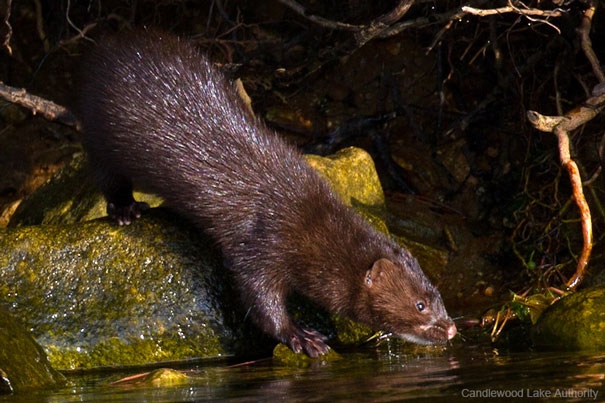
A quiet and solitary hunter stalks the shores of Candlewood Lake – looking for fish, rodents, crustaceans, and even birds. The American Mink is one of the more esoteric creatures of Candlewood and is the second feature in the CLA’s monthly column describing some of the other critters that call Candlewood Lake “home.” Rarely seen, the American Mink is a small, ferret-like mammal that is one of the most adept swimmers to dive into Candlewood’s waters.
American Minks are normally nocturnal hunters, creeping along the shore waiting for an unsuspecting fish or muskrat to swim by. Their nocturnal nature is why they’re not often seen by residents of the lake, but keen eyes might catch a mink venturing out in the day time to stock up on food for their den. Once it spots its target, the American Mink will deftly dive into the water (up to 16 feet!) and will pull its meal back onto shore. Though only 2 or 3 pounds at most, these able hunters have no problem grabbing prey equal to or larger in size than themselves. Even a three-pound thrashing trout is no match for the mink’s submarine-like swimming ability and sharp teeth.
The American Mink is native to most of North America above Mexico but has largely stayed out of the Southeastern US. Many of these charismatic animals call Connecticut their year-round home. Their fur coat has historically earned them a considerable reputation. Thick, short, and luxuriously soft, the Mink’s waterproof fur provides them the perfect warmth against cold winters and freezing water, allowing them to hunt year-round. Unfortunately, this fur coat has also garnered the attention of the fashion industry, where mink coats have become a staple of affluence and class. In fact, American Minks have been domesticated and transported to farms around the world to raise for the express purpose of making fur clothing. Some of the minks have escaped in places like Scotland, Russia, and South America. These escapees have established populations in these areas, making American Minks an invasive species. Similar to invasive species we deal with here, American Minks in these areas can wreak havoc on ecosystems, hunting and killing huge populations of native organisms in those areas. This is a good example of how organisms that fit well into native ecosystems can cause major problems in areas that they invade.
These small, beautiful creatures will bound happily along the shore, reserving their grace for diving and swimming. If you see a family of minks, you might hear them chattering to each other, or if you’re lucky enough to catch a happy mink, you might even hear it purr before it
takes a bite of a recently caught meal. These lovely hunters provide an important service to Candlewood Lake, and all the lakes and rivers they frequent. By preying on other “Creatures of Candlewood” the Mink ensures that the food web controlling population sizes in and around the lake remains stable and healthy. Plus, it doesn’t hurt that they’re particularly pleasant to watch when they’re hunting or playing on Candlewood’s rocky shores.
Though it was created by humans, Candlewood Lake now both serves and relies on the natural services provided by the organisms that live on and in its waters. It’s important for us as residents and users of the lake to recognize that we’re not the only ones who have come to depend on it. The solitary and adorable American Mink is just one of the many creatures of Candlewood we will continue to highlight in our “Creatures of Candlewood” column. To learn more about how to protect both the lake and the creatures who we call our neighbors, please visit our website at: www.candlewoodlakeauthority.org . If you are ever lucky enough to spot a Mink, we hope you stop and appreciate the part it plays in keeping Candlewood healthy and enjoy observing another fascinating resident of our beautiful lake.